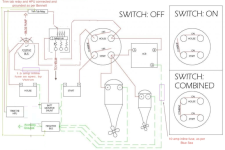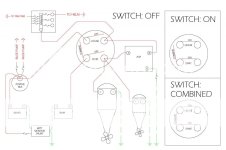Sunbeam
Active member
- Joined
- Feb 23, 2012
- Messages
- 3,990
- Reaction score
- 0
- C Dory Year
- 2002
- C Dory Model
- 22 Cruiser
Just thought I would update the thread.
When Blue Sea sent me out a replacement ACR, they also sent a call tag for me to return the one that seemed to be causing my problem. Once it got back to them, one of their techs "sawed it in half" and checked it over. He said that while it did work, it took a very long time to combine (i.e. longer than they usually do). At that time, he was trying to figure out how that would cause my fuse to blow when it combined.
I clarified that I never had a problem when it combined, but rather it was when it isolated. He couldn't immediately think of any reason it would cause that, but said he would talk it over with some other folks at Blue Sea. The new ACR seems to have solved my problem, but of course I'm still curious about the original one.
Once I had put in the new ACR and tested it with things arranged as they had been (so as not to change a bunch of variables), I made some changes to the electrical system based on new things I had learned.
1) Added the 10 amp fuse to the ground wire on the ACR, as recommended.
2) Moved the main fuse to the "downstream" side of the main battery switch*.
Once I get supplies, I'll be upsizing the helm feed wire (and then the main fuse to correspond properly) and tidying up behind the helm (not really changing anything fundamentally there, but putting in a new/larger fuse block, labeling and organizing, etc.).
*More detail on #2:
I didn't move any components physically, but changed some wiring around.
a) What was a positive bus downstream from the main battery switch is now functioning as a "power post" between the house battery and the main switch, and handles the two bilge pump leads (which want to be "hot" all the time). They each have an inline, water-resistant blade fuse. I'm not at the boat now, but IIRC, I also moved the positive wire for the battery monitor shunt there (was on the house battery positive post).
b) The Safety Hub, which is now downstream of the switch, (still) has the helm feed wire/fuse in one of the "big" AMI/Midi fuse spots - and now one of the blade fuse slots is used for the trim tab feed.
I'm not sure whether I will hook up the start isolation function on the ACR. I started to do that, and found that I needed to connect it to the brown wire in my engine ignition circuit. One end of that is in the Yamaha engine control box next to the helm seat. I opened that up but it doesn't look like a "nice" spot to add a butt connector/wire (pretty tight in there). I think the other option would be inside the engine where the wires come into it, but I'm not super keen to take that apart again (although I may) (I had it all apart when I replaced the fuel hose from the Racor into the internal Yamaha fuel filter).
In speaking with Blue Sea, they felt that with a main in the 80-90 hp range, start isolation wasn't really necessary. Anyone have any agreement/disagreement on that? Obviously I have not had any issue yet, and if I don't need it, great, one less finicky wiring job to do. OTOH, if it is necessary, then I'm going to hook it up, even if it is difficult.
Sunbeam
When Blue Sea sent me out a replacement ACR, they also sent a call tag for me to return the one that seemed to be causing my problem. Once it got back to them, one of their techs "sawed it in half" and checked it over. He said that while it did work, it took a very long time to combine (i.e. longer than they usually do). At that time, he was trying to figure out how that would cause my fuse to blow when it combined.
I clarified that I never had a problem when it combined, but rather it was when it isolated. He couldn't immediately think of any reason it would cause that, but said he would talk it over with some other folks at Blue Sea. The new ACR seems to have solved my problem, but of course I'm still curious about the original one.
Once I had put in the new ACR and tested it with things arranged as they had been (so as not to change a bunch of variables), I made some changes to the electrical system based on new things I had learned.
1) Added the 10 amp fuse to the ground wire on the ACR, as recommended.
2) Moved the main fuse to the "downstream" side of the main battery switch*.
Once I get supplies, I'll be upsizing the helm feed wire (and then the main fuse to correspond properly) and tidying up behind the helm (not really changing anything fundamentally there, but putting in a new/larger fuse block, labeling and organizing, etc.).
*More detail on #2:
I didn't move any components physically, but changed some wiring around.
a) What was a positive bus downstream from the main battery switch is now functioning as a "power post" between the house battery and the main switch, and handles the two bilge pump leads (which want to be "hot" all the time). They each have an inline, water-resistant blade fuse. I'm not at the boat now, but IIRC, I also moved the positive wire for the battery monitor shunt there (was on the house battery positive post).
b) The Safety Hub, which is now downstream of the switch, (still) has the helm feed wire/fuse in one of the "big" AMI/Midi fuse spots - and now one of the blade fuse slots is used for the trim tab feed.
I'm not sure whether I will hook up the start isolation function on the ACR. I started to do that, and found that I needed to connect it to the brown wire in my engine ignition circuit. One end of that is in the Yamaha engine control box next to the helm seat. I opened that up but it doesn't look like a "nice" spot to add a butt connector/wire (pretty tight in there). I think the other option would be inside the engine where the wires come into it, but I'm not super keen to take that apart again (although I may) (I had it all apart when I replaced the fuel hose from the Racor into the internal Yamaha fuel filter).
In speaking with Blue Sea, they felt that with a main in the 80-90 hp range, start isolation wasn't really necessary. Anyone have any agreement/disagreement on that? Obviously I have not had any issue yet, and if I don't need it, great, one less finicky wiring job to do. OTOH, if it is necessary, then I'm going to hook it up, even if it is difficult.
Sunbeam


